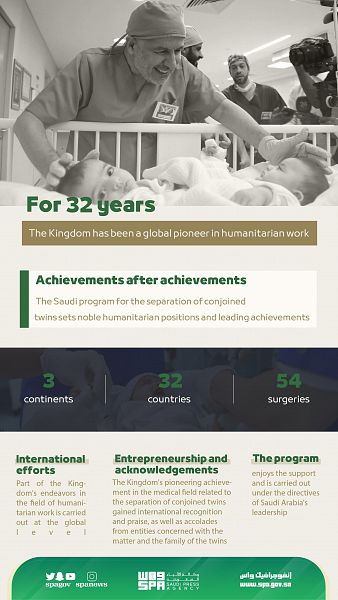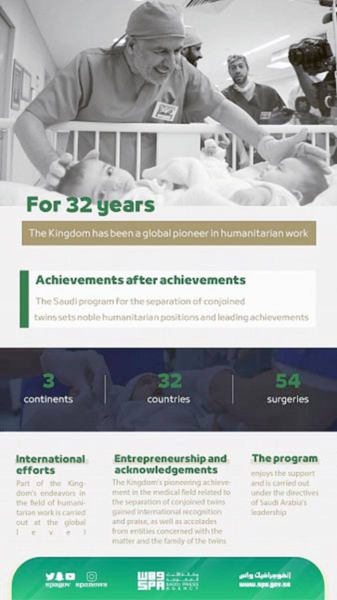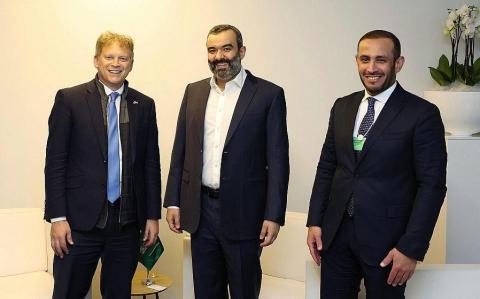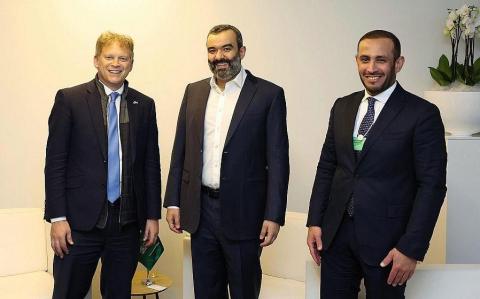
Riyadh, February 20, 2023, SPA -- The Kingdom of Saudi Arabia is known for excellence in various charitable fields, where it has always been among the first countries in charitable, humanitarian and relief works.
Among these fields is separating Siamese twins, where the Kingdom of Saudi Arabia has realized international entrepreneurship and receives the praise of other countries and relevant organizations, in addition to the families of the twins.
For 32 years, the Saudi program for separating conjoined twins has performed 54 successful separation surgeries on Siamese twins. The beginning of these surgeries, implemented by the King Salman Humanitarian Aid and Relief Centre (KSrelief), led by the head of the team, Advisor at the Royal Court and Supervisor General of the KSrelief Dr Abdullah bin Abdulaziz Al Rabeeah, was on December 31, 1990, where these successes continue until the present. The program, since its establishment, has assessed 127 Siamese twins from 23 countries in three continents and conducted 54 successful surgeries to separate Siamese and parasitic twins, the latest of whom are the Iraqi Siamese twins, Ali and Omar.
In an interview with the Saudi Press Agency (SPA), Dr Al Rabeeah said that the actual start of the separation surgeries journey was the surgery of the Sudanese twins, Samah and Hiba, in 1992, which was accompanied by forming a specialized team for such surgeries, adding that following the success of the surgery, Samah and Hiba lived in the Kingdom of Saudi Arabia and completed their master’s degree.
As part of its humanitarian role, the Kingdom has received Siamese twins regardless of race to alleviate the suffering that they and their families endure, which is a feature of the Kingdom that has set and continue to be an example for responding to the calls of twins’ families and alleviating their suffering until Saudi Arabia has become a haven for them.
Scientifically, there are no specific reasons for conjoined twins. However, scientific findings, according to Dr Al-Rabeeah, demonstrate that conjoined twins occur only in women who give birth to identical twins from one egg and for genetic reasons, and this occurs in a rare and a tiny percentage of one in a thousand.
The darker the skin, the more conjoined twins can occur. In Africa, identical twins are more likely to happen than in Europe, most commonly in the southern areas, which are more likely to witness such cases than its northern parts. It is essential that the pregnant woman periodically visits her doctor at the beginning of the pregnancy to check on her health and that of her fetus, mainly because the discovery of twins at the beginning of pregnancy entails following a particular course, where in many cases, twins can be detected at the age of 8 to 9 weeks of pregnancy, which is the critical time to assess the effect on the mother’s health.
The medical, humanitarian and social consequences of the Siamese twins have negative impacts on the father and mother when they feel sad about the conditions of their children who have come into the world carrying illnesses and deformities. However, the Saudi program for separating Siamese twins has restored hope to these humanitarian situations, and brought optimism for a bright, healthy future and removed all burdens of families of conjoined Siamese twins.
On the mechanism for assessing the status of Siamese twins and what they need, Dr Al-Rabeeah says: The Saudi program for separating Siamese twins evaluates each twin separately, depending on their health condition to identify the joint organs and their condition, before selecting the medical team that will take part in the surgery. For example, adhesion to the chest is determined by the specialized team, where the team specializing in that field is selected; thus, each case is determined by the places of adhesion in the twin organs, which encouraged the Kingdom to combine all these specializations in one place.
In this highly specialized area of medicine, the program has managed to conduct 54 successful separations of Siamese twins, and the Kingdom prides itself on high-quality national medical competencies, and state-of-the-art equipment and devices that meet the latest scientific standards in this precise surgical field.
It is evident that the Siamese twins need many things after the separation surgeries, such as periodic follow-ups and have physical variables that require the medical team that performed the operation to continue follow-ups. In the case of twins living in another country, it is necessary to communicate with the competent team supervising the surgery. The psychological aspect of the conjoined twins is also of great importance for managing the “post-operative separation trauma”, primarily as they are used to be conjoined while in their mother's abdomen and after their birth during their first months of being born; hence, the longer the period before the surgery, the greater the psychological link between the twins is.
The twins also need to share one room and be brought close together. It is essential that the separation be gradual rather than sudden. This task is what the specialized psychiatric team within the medical team of the Saudi program for the separation of Siamese twins undertakes.
As Saudi Arabia's expertise in dealing with Siamese twins has increased, visions and objectives have expanded as well, not only through medical interventions but also through the establishment of a comprehensive national program at humanitarian and scientific levels, specializing in the separation of conjoined twins, which marked a milestone for the Kingdom of Saudi Arabia globally, where the Saudi program for the separation of Siamese twins is the only one of its kind worldwide to cover all the expenses of surgeries, treatment and post-operation rehabilitation, in addition to hosting the parents of twins coming from abroad to stay close to their children and check on them throughout the period of the medical care.
As the Kingdom of Saudi Arabia seeks to be at the top in all fields, including the humanitarian area of separating Siamese twins, the program continues to add medical and national personnel to every new surgery, where it has three teams. It also has elite Saudi doctors who deliver scientific lectures and publish research on the separation of twins in many countries.
These results reflect the high levels and efficiencies that the Kingdom of Saudi Arabia has realized in this precise surgical specialization and reflect the magnitude of expertise and knowledge that the Kingdom has gained in the field of separating Siamese twins. The Kingdom’s leading role in separating Siamese twins is not limited to medical entrepreneurship, but also includes humanitarian entrepreneurship, where the Saudi program for the separation of Siamese twins receives direct attention from the leadership of the Kingdom that always issues directives to receive twins and conduct separation surgeries.
The government of the Custodian of the Two Holy Mosques, King Salman bin Abdulaziz Al Saud and His Royal Highness Prince Mohammed bin Salman bin Abdulaziz, Crown Prince and Prime Minister, is unique in attaching such importance to cases of the Siamese twins in the world, where the program is part of the Kingdom’s efforts in the field of humanitarian work at the international level.
--SPA
10:03 LOCAL TIME 07:03 GMT
0008
www.spa.gov.sa/w1856525











